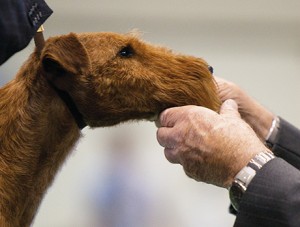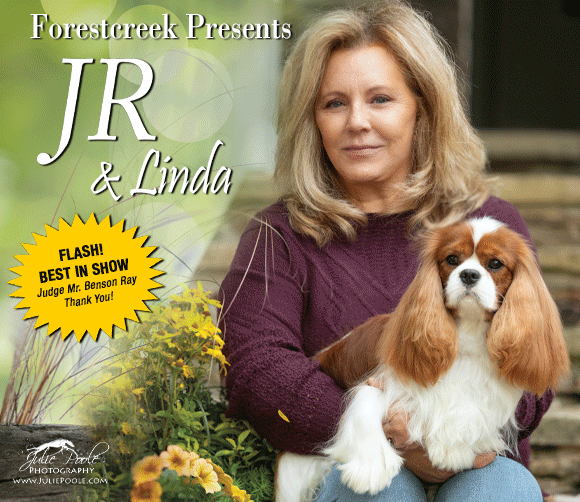A Judging Technique
By Herman L. Felton
From the archives of The Canine Chronicle – February 1997
 As I am wont to wonder, now that I am approaching advanced maturity and tend toward remembrance of things past rather than to future anticipation: Did what I did make increasing sense and show some degree of intellectual progress as time passed; or did I fall into a rut early on and go with the flow? Hair graying, waistline thickening but brain in neutral; an all too common syndrome.
As I am wont to wonder, now that I am approaching advanced maturity and tend toward remembrance of things past rather than to future anticipation: Did what I did make increasing sense and show some degree of intellectual progress as time passed; or did I fall into a rut early on and go with the flow? Hair graying, waistline thickening but brain in neutral; an all too common syndrome.
During decades of judging purebred dogs, I have evolved a philosophy and a technique I am very comfortable with and which best enables me to fulfill my good judging criteria:
Judging is, to a substantial extent, an exercise in concentration from beginning to end. It should be performed in such a manner that the judge’s ability to recall each detail about each entrant is enhanced.
A. Find and reward the best specimens of the breed in the ring at a given time based on your understanding and interpretation of the breed standard.
B. Judge the whole, overall dog.
C. Disregard the handler of the dog.
D. Try to judge in such manner that an interested and attentive spectator can understand what you are looking for and follow your reasoning.
E. At the appropriate time, rearrange the class to reflect your opinions of the entrants at the latter stages of the process so as to have the contenders close to each other for easier comparison.
F. Be decisive and consistent. Don’t go over the same feature again and again. You won’t see any more the third time than you did the first and second.
G. Don’t just stand and stare. Don’t wait for divine guidance.
H. Almost always, your first impressions are the most valid. Don’t overload and confuse your brain circuitry by too much re-examining, re-visiting and re-evaluating.
I. Don’t get afterthoughts and suddenly change the emphasis of your decision-making process.
J. Over years of observing and studying excellent specimens of the breed you judged, you have undoubtedly formed a mental picture of a “good one”. Use this as your guide. Don’t go with the “advertising” or “handler” flow.
K. Be consistent honestly, not superficially. Respect yourself. You will make an occasional “mistake” (perhaps realized when you see your Best of Breed dog in the group ring) but make this a part of your continuing improvement as a judge.
L. Continue to be a student of each breed that you judge even after you may feel that you have earned your PhD in the subject. We all know that there is a continuing evolution going on in all the breeds which cannot be disregarded.
Well, enough of philosophy, let’s get to technique. Judging is, to a substantial extent, an exercise in concentration from beginning to end. It should be performed in such a manner that the judge’s ability to recall each detail about each entrant is enhanced. Utilize a judging procedure you are comfortable with. What I have developed for myself over the years and makes sense to me is:
1. If possible (and it generally is) get all the dogs in the ring into a circle around its periphery. I prefer them to be in catalog order. Standing as far from the dogs as you can within the ring, make a quick visual survey of the class to get a preliminary ‘feel’ for its quality.
2. Moving closer to the line of dogs standing broadside to you, look over each individual specimen noting size, body proportions, angulation, static balance and profile “type”. In a smaller or medium-sized class, I mentally utilize an identity code for each dog I like at this stage by its place in the line (1,3,5,6,10,12, for example.) In large classes, preferred dogs are coded by what their handlers are wearing (lady in green top and red skirt, man in blue jacket and khaki pants, man in red jacket, lady in gray dress and white shoes, etc.). This works for me, but you may prefer some other method.
3. Move to the head of the line of dogs and visually examine the head, eyes, expression, bone, feet and width and quality of front of each entrant as you move from the front of the line to the rear. Select and code those you like best.
4. Starting at the end of the line, stand over the rear of each specimen looking toward its front. Note width of neck, how it flows into the body, placement of the shoulders, spring of ribs and length of rib cage, length and width of loin, musculature and width of rear. (Real vital information) Again, mentally code the preferred dogs.
5. Trot the class one or two laps around the ring at a moderate speed. Determine kinetic balance, reach and drive. Note and code the better ones.
6. Now each dog is hand examined on the ground or on the table and gaited individually. Bite, missing teeth (where appropriate), and–particularly in a heavily coated breed–angulation, ribs, topline, depth of chest, trueness of hocks, coat texture, going and coming gait, side gait, etc. can be evaluated and preferred specimens noted and coded. Look for presence or absence of breed characteristics. During the hand examination don’t just pat the dogs aimlessly as if powdering or petting them. Let your fingers outline what it is you are probing for and finding.
7. You now have enough information to rearrange the class in order of preliminary preference. (And to cut the class if it is large enough to be unwieldly). Based on steps 2, 3, 4, 5, and 6, you know which individuals you found to be, overall, of the highest quality and you line these up in a new order so that the most competitive are close to each other. You may want to re-examine or re-gait any or all of the first six or just certain ones to determine your final four ribbon winners. Moments later you can point “one, two, three, four.”
In describing this technique in writing, I realize that it may sound like a long, drawn-out procedure but, in actuality, it is quick, concise and decisive. In decades of judging, I have never found this method, properly utilized, to be an obstacle to judging at a rate of 25 to 30 dogs per hour.
I am not trying to be artful or persuasive, just presenting an alternative process for your consideration.
[Editor’s Note: The following was written in 1997. Then-president Judy Daniels proposed consolidating AKC’s headquarters in Raleigh, NC as par of a large campus for learning about and promoting purebred dogs.]
Turning yet again to the subject of the AKC’s relocation, the most important and urgent matter on our current agenda, it needs to be strongly emphasized that different criteria should be applied than would be in the case of a for-profit organization. The mission of the AKC represents emotion in addition to the need to “make money”. A very small percentage of the people involved in the Sport of Purebred Dogs are in it for the money. The “profit” almost all participants earn is intangible but satisfying. And so it should be.
The cost of a once-in-a-lifetime purchase and construction of an all-inclusive AKC headquarters complex should be “amortized” over a one-hundred year period rather than by a short term commercial concept. Our success is not measured by what we “make” in the next quarter or year, it is in the long-term welfare, satisfaction and progress of the humans and dogs involved in the Sport.
We must be fiscally conservative but, at the same time, we need to fulfill our ultimate responsibility to the future advancement, well-being and prestige of the AKC and the Sport of Purebred Dogs.
Short URL: https://caninechronicle.com/?p=279672
Comments are closed












